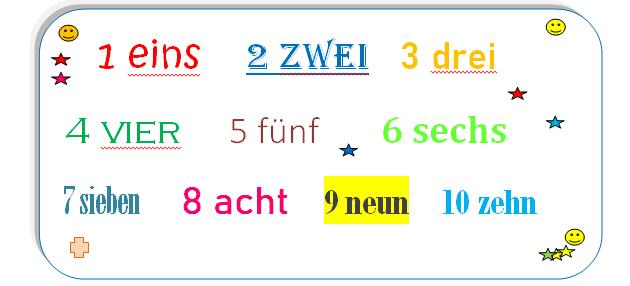In this lesson, you will learn about German cardinal numbers. You will also discover helpful tips for counting from 1 to 100 and even up to 1,000,000. Cardinal numbers, also known as Arabic numbers, are typically among the first concepts learned when studying a foreign language. Let’s examine how they are spelled.
Thank you for reading this post, don't forget to subscribe!CONTENTS
Cardinal numbers up to 12
German numbers from 13 to 19
Tens in German
Numbers between tens
Hundreds
Thousands
Usage with the numerals
German numbers up to 12
It is a good idea to memorize the numbers from 0 to 12. The numbers from 1 to 10 are the foundation for building larger numbers, so knowing them well will make it easier to learn other numbers. You might wonder why I included 11 and 12. This is because they differ from the others by having “teen” in their names, and it’s best to memorize them immediately.
0 null, 1 eins, 2 zwei, 3 drei, 4 vier, 5 fünf, 6 sechs,
7 sieben, 8 acht, 9 neun, 10 zehn, 11 elf, 12 zwölf
German numbers from 13 to 19
This is very easy, if you have learned how to count from 1 to 10, then no worries, you will master these numbers with the speed of light. Here the numbers 3 to 9 merge with the number 10.
3 drei + 10 zehn = 13 dreizehn
4 vier + 10 zehn = 14 vierzehn
5 fünf + 10 zehn = 15 fünfzehn
6 sechs + 10 zehn = 16 sechzehn
7 sieben + 10 zehn = 17 siebzehn
8 acht + 10 zehn = 18 achtzehn
9 neun + 10 zehn = 19 neunzehn
I have crossed out the exceptions, in number 6, the letter ‘s’ is missing, and in number 7, the suffix ‘-en’ is omitted.
Tens in German
Tens are built by adding the suffix -zig to the numbers from 2 to 9, again of course we have a few exceptions ☺
| 10 zehn | |
| 2 zwei | 20 zwanzig |
| 3 drei | 30 dreißig |
| 4 vier | 40 vierzig |
| 5 fünf | 50 fünfzig |
| 6 sechs | 60 sechzig |
| 7 sieben | 70 siebzig |
| 8 acht | 80 achtzig |
| 9 neun | 90 neunzig |
You must have already noticed, thirty is pronounced with the German letter s: dreißig. Numbers 60 and 70 again lose the suffix –s and –en.
Click on:
Grammar Contents
Numbers between tens
This is easy as well, although it seems to you that it is not. Germans count two-digit numbers in the opposite direction from us.
| we count like this: | Germans count like this |
| twenty – one twenty – two twenty – three twenty – four | one – and – twenty two – and – twenty three – and – twenty four – and – twenty |
Let’s see how it looks in German:
21 einundzwanzig, 22 zweiundzwanzig, 23 dreiundzwanzig, 24 vierundzwanzig, 25 fünfundzwanzig,
26 sechsundzwanzig, 27siebenundzwanzig, 28 achtundzwanzig, 29 neunundzwanzig
This also applies to other tens up to 100 (hundert).
For example:
31 – einunddreißig
42 – zweiundvierzig
53 – dreiundfünfzig
64 – vierundsechzig
75 – fünfundsiebzig
86 – achtundsechzig
97 – siebenundneunzig
At first, this may seem very unusual, and you may think you will never learn it, but don’t worry. Everything takes time and practice, and over time, it will sound completely natural to you.
Hundreds
The number from 1 to 10 + – hundert
100 – (ein)hundert , 200 zweihundert, 300 dreihundert, 400 vierhundert, 500 fünfhundert, …. 900 neunhundert
The number from 1 to 10 + – hundert + one-digit or two-digit number
101 – einhunderteins, 121 – einhunderteinundzwanzig, 254– zweihundertvierundfünfzig,
578 – fünfhundertachtundsiebzig
Thousands
The number from 1 to 10 + – tausend
1000 – (ein)tausend , 2000 zweitausend, 3000 dreitausend, 4000 viertausend, 5000 fünftausend
The number from 1 to 10 + – tausend + – hundert + one-digit or two-digit number
2708- zweitausendsiebenhundertacht, 6128 sechstausendeinhundertachtundzwanzig
1 000 000 – eine Million
1 000 000 000 -eine Milliarde
Usage of Numerals in German
- “Ein” is pronounced with the ending -s when it stands alone, e.g.: eins (one) or zweihunderteins. (two hundred one). – However, when “ein” is combined with other numbers, such as in “einundzwanzig” (twenty-one), there is no -s sound.
- “Zwo” is, in spoken German, especially on the telephone, commonly used instead of “zwei” (two) to avoid confusion with “drei” (three).
- Decimals are written with a comma in German:
1,9 ( eins Komma neun)/ English: 1.9
2,5 (zwei Komma fünf)/ English: 2.5
0,4 (null Komma vier)/English: 0.4 - Long numbers are hardly ever written out in full except on cheques. If they are written out, they appear as a single word.
- Numbers from ten thousand are written with spaces or, sometimes, a point every three digits: 564 297 or 564.297. Note that this differs from English, where a comma is used instead of a point.
German: 1 000 000 = English: 1,000,000. - Eine Million, eine Milliarde, eine Billion are treated as separate nouns. They are written (and spoken) separately and have plural endings where appropriate.
- For numbers higher than a million, German differs from English. For example:
1 000 000 000 eine Milliarde / a billion
1 000 000 000 000 eine Billion / a trillion - The currency of Germany as well as of most of Europe is der Euro (€). When stating the cost of an item, euros and cents are mentioned separately. In written form, they are separated by a comma. This should provide a clearer understanding of how numbers are used in German!
For example: - Es kostet 6,74E. ( sechs Euro vierundsiebzig Cent) It costs 6 euros 74 cents.
- Es kostet 14, 30 E ( vierzen Euro dreißig Cents) – It costs 14 euros 30 cents.
I hope I didn’t miss anything! 🙂 It will be my pleasure to answer your questions, if you have any.
See more:


